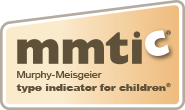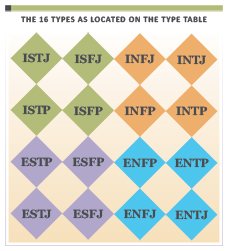
Why Become Certified to Use the MMTIC® System?
 Are you considering becoming certified to use the Murphy-Meisgeier Type Indicator for Children® (MMTIC®) assessment with children? If so, you're in the right place! On this page, we explain why using personality type as measured by the MMTIC assessment is the right choice for you, children, classrooms, and families.
Are you considering becoming certified to use the Murphy-Meisgeier Type Indicator for Children® (MMTIC®) assessment with children? If so, you're in the right place! On this page, we explain why using personality type as measured by the MMTIC assessment is the right choice for you, children, classrooms, and families.
Personality Type
Most of us have injured our dominant hand at some point and had to write or do everyday tasks with our nondominant hand. How well did that go? We can do it, of course, but it's just not as easy! If we practiced using our nondominant hand more, we'd get better and better at it, though never quite as good as when we use our dominant hand.
Personality type, based on C. G. Jung's theory of psychological types and made popular through Isabel Briggs Myers' MBTI® assessment, works in the same way! The preferences we have within our personalities indicate our dominant and nondominant "hands," so to speak, what we refer to as our strengths and stretches. Parts of our personality are easy to access, whereas other parts can be more challenging.
Personality type identifies four pairs of opposites, known as preferences, in four areas of living:
- how we direct and receive energy—Extraversion or Introversion;
- how we take in information—Sensing or Intuition;
- how we make decisions—Thinking or Feeling; and
- how we approach our lives—Judging or Perceiving.
If you prefer Extraversion, you naturally gravitate toward connecting with others socially and asserting yourself. However, this does not mean you do not enjoy time alone sometimes; it just means you prefer to engage with life in an extraverted way. In this case, Extraversion is your strength and Introversion is your stretch. You use both, like you use both hands, but like your preferred hand, one of the preferences in each pair will seem more natural and comfortable to you.
Personality type is that simple, but do not be fooled into thinking it is a simplistic system. This is a developmental model that guides us in how to grow and mature in all aspects of our personality type throughout the life span. Type awareness allows all of us to better understand our natural styles for communicating, learning, problem-solving, managing stress, exploring career interests, and more.
BACK TO TOP
The MMTIC System
As a parent, elementary school teacher, and certified MBTI practitioner, Elizabeth Murphy, EdD, was inspired by the MBTI system for adults—she saw the value that personality type could bring to K–12 students. In her 1986 doctoral dissertation, she created the Murphy-Meisgeier Type Indicator for Children (MMTIC) assessment with her professor, Charles Meisgeier, PhD.
- Adults verify their personality type preferences through the MBTI assessment; young people verify their personality type preferences through the MMTIC assessment.
- The MMTIC model is based on the MBTI model of personality type.
- Evidence-based and data-driven, the MMTIC assessment is used in research and K–12 schools nationally and internationally.
- Myers & Briggs Foundation is the MMTIC publisher, and People Stripes is the home of the MMTIC system, where we foster community, train certified facilitators, and distribute the assessment and materials.
MMTIC practitioners are trained in type development and how best to work with young people who are still developing their preferences, which is quite different than working with personality type in adults.
There are MMTIC practitioners around the world from a variety of fields, such as educators, counselors, healthcare providers, career coaches, and more. Building self-esteem, self-confidence, and self-awareness are just some of the reasons these practitioners find value in using the MMTIC system with the young people they serve.
MMTIC Practitioners
- Practitioners are certified MMTIC professionals who have invested their time into learning the system through our MMTIC® Certification Program. The program is asynchronous, requires around 15 hours of study followed by an exam.
- MMTIC practitioners access the MMTIC® Facilitator Interface to purchase, administer, manage, organize, and generate reports.
- People Stripes offers learning resources through online articles and purchasable books for practitioners and families.
- Practitioners have access to the MMTIC assessment and a range of reports, such as Student, Professional, Career, and Test Preparation, as well as support materials.
BACK TO TOP
Applications of the MMTIC System
- The MMTIC assessment has a long history of research on the impact that leveraging personality type has on enhancing learning, increasing self-awareness and self-management, facilitating meaningful career and college major choices, and providing a bridge to understand others.
- Practitioners promote self-understanding that enhances the learning process and supports creating a culture of belonging, appreciation of differences, and life readiness.
- Major areas of impact are in Academic Development, Career Development, and Social & Emotional Development.
Academic Development
In a Texas classroom, teachers were trained to incorporate personality type into the choices given to students and their lesson plans. When students were given lesson plans that directly addressed their natural preferences, they achieved better academic results.
After learning about how we naturally have strengths and stretches in our personality type, a third-grade student in North Carolina approached her teacher and asked if she could intentionally stretch into a less favored preference in a specific assignment. The student had been taught that everyone has skills that are naturally easier than others, and that stretching into ones that are not as easy for us helps us grow.
The study in North Carolina produced a result we call advocating for their choices, where students made choices based on knowledge of their personality type. Some of these choices were to adapt a lesson or assignment to their natural personality type preferences, and some were to intentionally stretch to the opposite preferences to practice new skills, accepting that they may not do as well on the assignment.
BACK TO TOP
Career Development
One of the largest areas of research and application of personality type with students (and adults) is in career and college major choices. When the role and function of a job and/or profession a person holds are aligned with dominant personality preferences, people report higher satisfaction in their work. Building on this, People Stripes offers a Career Report for middle and high school students based on their personality type. This report offers insights into the various tasks that certain types find appealing and the tasks they may find draining and thus less interesting.
Certified MMTIC facilitators use personality type to counsel students, individually or in groups, on the type-related tasks and work environments that are most likely to engage their strengths and interests. Because our jobs always include tasks or responsibilities that we do not like as much, an MMTIC facilitator also guides students on how to use stretches as a powerful method of learning and self-development.
Social & Emotional Development
Self-awareness is the foundation of emotional and behavioral self-management. Personality type is a core aspect of this foundation, providing accessible, usable information in unbiased language about how our minds are naturally structured. The concepts of strengths and stretches are a great example of nonjudgmental terms that clearly describe a universal human reality: each one of us is born with innate gifts and corresponding areas that are not so easy for us—and this is nothing to be embarrassed about!
Through our interventions that educate professionals and students on MMTIC personality type, we increased a sense of belonging in the classroom as students extended knowledge of their own personality type to their classmates without bias. That is, as students understood that their own personality was a mixture of gifts and challenges and that this was okay, they were able to see and appreciate the differences in others in the same way.
In a focus group, a third-grade boy acknowledged that he now understood that his classmate and friend, a young girl, preferred Introversion, which was different from his preference for Extraversion. With a smile, he was able to identify the different behaviors each of them expressed and affirm that it was okay they were not the same! At People Stripes, we call this the constructive use of differences—a core skill in valuing the diversity in ourselves and other people.
BACK TO TOP



_thumb.png)




